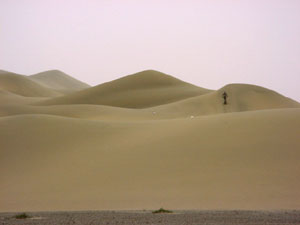![]()
| Gansu, China | Dunhuang | 2002.07.25 - 07.28 |
Mogao Caves
In the vast desert of Gansu Province, near the borders of Xinjiang and Qinghai Provinces, is a pleasant but overpriced tourist town called Dunhuang. Dunhuang draws crowds from around the world to see the Mogao Caves, the oldest known Buddhist caves in China. These caves were once nearly inaccessible due to the harsh desert climate, lack of transportation, and Chinese government restriction. Today the atmosphere is more like an amusement park than an ancient religious site.
GETTING TO DUNHUANG
The closest train station to Dunhuang is Liuyuan, 14 hours by express train from Lanzhou to
the east and 10 hours by express train from Ürümqi to the west. Buses depart from
the front of Liuyuan train station to the center of Dunhuang 130km to the south. This bus
ride takes between 2~3 hours and costs ¥15. There is no fixed bus schedule. They depart
when they're full. If you get stuck in Liuyuan for the night (like we did both going and on
the return), there are several accommodation options and some decent restaurants around
the train station parking lot.
MOGAO CAVES
The earliest Mogao Caves date back to the 4th century. Most caves were added
through the end of the Tang dynasty (907 A.D.). Each cave is a rectangular cavern
cut into a desert mountainside. Today, a locked metal door covers each cave entrance.
For the proper price, a guide unlocks each door for viewing.
Terracotta Buddha statues and Buddhist wall paintings decorate the interiors. Many
of the statues and frescos are crumbling. They lack detail and appear rather
amateurish. Photographing the Buddhist artwork is prohibited, and honestly, little
is photogenic enough to warrant a snapshot. A short visit to the Mogao museum
sheds light on the reason for the lack of stunning relics. The British and French
carted home practically everything of interest in the early 1900s. To see the
best works requires a visit to the British Museum (London) and Le Louvre (Paris),
not Dunhuang. Unfortunately, viewing the works in Europe, outside the environment
where they were created, enormously detracts from the experience.
The Mogao Caves are promoted as the best ancient Buddhist grottos in China, and our expectations were high, having already visited the Buddhist caves in Dazu and Datong. We preferred the caves in Datong. We were disappointed with the artifacts on display and the restricted access at Mogao. Considering the time it takes to reach Dunhuang from any city, a visit is only worthwhile if you have a deep interest in Buddhist art.
Basic entrance to the Mogao Caves is ¥80. This enables you to plod behind a Chinese-speaking guide as he or she unlocks a random set of 5 or 6 (out of the 30 that the ¥80 ticket entitles viewing of) cave-access metal doors in the course of a 1-hour tour. To see more caves requires skipping forward to one guided group and back to another since each guide opens a different set of doors. Why each guides doesn't show the full 30 cave circuit is a mystery to us. Visiting during low tourist season is a mistake in Mogao since very few guides will be opening even fewer doors.
In addition to the 30 basic-fee caves are several hundred "additional-fee" caves. These can cost ¥60, ¥100, or even ¥200 per cave. Again, high tourist season has an advantage. We wandered freely on our ¥80 ticket, popping in and out of unlocked cave doors as we found them. Some of these were additional-fee caves that we got a good look at before being requested to leave. To our uneducated eyes, the expensive caves looked no different than the basic caves. We would have been really disappointed to pay these outrageous sums of money for such little return.
GETTING TO MOGAO CAVES
Minibuses depart from the Dunhuang Fandian (Hotel), one block from the Dunhuang
bus station, when they are full, which is generally
around 08:00. When the bus reaches Mogao, the attendant announces the return time.
The usual return times are 12:00 and 16:00. Bus fare is ¥5 each direction.
XI QIANFO DONG
The Xi Qianfo Dong, or Western Thousand Buddha Caves, is another grotto site
promoted by Lonely Planet and local touts. Direct transport to the 35km distant
caves limited to taxi. Taxis charge a standard ¥1.1 per kilometer and do not
charge for wait time as you view the 3~5 caves for a total of about 10 minutes.
Cave frescos are completely discolored and much of the wall surface is crumbled.
What remains isn't worth the taxi fare to visit. Admission is ¥40 if you want
a ticket or ¥20 otherwise.
SAND DUNES
South of Dunhuang is a 35km long stretch of sand dunes. Closest to Dunhuang are
the sand dunes at Crescent Moon Lake where a ¥20 admission is charged. Further
south, the dunes are free to roam. We walked the dunes near Xi Qiango Dong, located
about 2km from the cave site. Although the dunes look distant, they're actually
easily reached in 20~30 minutes walking time. Walking on the dunes was our highlight
in the Dunhuang area, and it was the only thing we thought worth photographing.
 |
30 minutes walk from the Western Thousand Buddha Caves, Masami begins her climb up the vast sand dunes. |
 |
From atop a small sand dune we gaze to the north. This seemingly endless expanse of sand stretches to Dunhuang 35km north. We never expected China to have such large sand dunes equaling those in Merzouga, Morocco. |
Copyright © 2000-2002 Wes and Masami Heiser. All rights reserved.